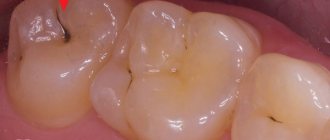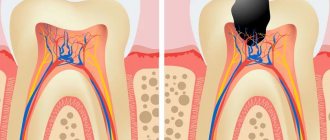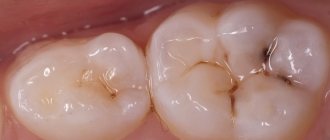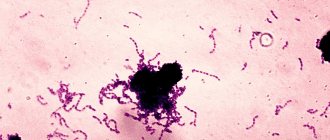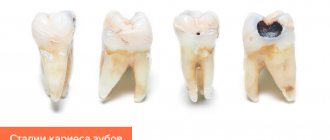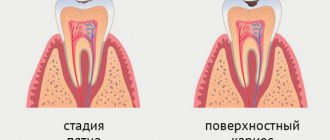Myth: Braces cause tooth decay.
Of course, braces themselves do not cause caries. But they can create conditions for its development.
The main problem is the impossibility of complete oral hygiene, since braces are a complex system with many small elements and micro-gaps. Even using brushes or an irrigator, regular brushing of teeth and following a special diet does not guarantee one hundred percent removal of plaque. As a result, caries under braces develops very quickly, especially in places that are difficult to reach with a toothbrush.
Braces also complicate the process of self-cleaning of the oral cavity, which is why caries progresses quickly. Therefore, it is necessary to treat caries with braces immediately after it is identified, without waiting for the end of orthodontic treatment when the braces are removed.
Symptoms and manifestations
Most often, caries develops in places where bacterial plaque accumulates, that is, in the area where the brackets fit into the enamel surface, as well as at the neck of the tooth.
Damage can be determined by the following manifestations:
- a chalky or yellow spot appears on the enamel , indicating the beginning of the process of demineralization of dental tissues;
- Over time , the stain darkens, becoming brown . It has a smooth shiny surface. There are no visible signs of tooth decay;
- at the site of pigmentation, the enamel becomes painful , reacting to thermal and chemical irritants;
- in the absence of therapeutic intervention by the dentist, a visible defect in the form of a depression forms , formed as a result of the destruction of the surface layer of enamel.
If, after the destruction of a section of enamel, you do not seek help from a dentist, then caries will lead to dentin deformation and can damage the pulp.
Caries during treatment with aligners
From the point of view of preventing and treating caries, mouthguards are more convenient than braces.
Oral hygiene with aligners is effective and simple: you remove the aligners, brush your teeth as usual, rinse the aligners themselves and put them back on. While braces retain food debris, aligners do not in any way prevent the teeth from being thoroughly cleaned. Accordingly, the risk of developing caries is less than with treatment with braces.
If caries does occur, treating teeth with aligners is also much more convenient. We said above that caries can be treated with braces, but sometimes you have to peel off the bracket or remove the arch. The aligners are simply removed, and the doctor gets full access to the teeth.
How is caries treated under braces?
If, while wearing braces, it turns out that caries has appeared on your teeth, be it a white spot or a cavity, your dentist will recommend treating it as soon as possible. It is important to understand that braces are not a contraindication to caries treatment.
If the arch does not block access to the affected area, then you won’t even have to remove the system to treat the tooth. But if a lesion is found under the brace or in a hard-to-reach area, the structure will have to be removed. Sometimes it is enough to remove only one bracket. It all depends on the location of the caries and the scale of the lesion. After the treatment is completed, the orthodontist will reinstall the device for the patient.
Otherwise, caries while wearing braces is treated in the same way as without them. First, the stage of the disease is determined, and then the optimal method is selected. If the pathology is at an early stage and there is no cavity in the tooth, the dentist can perform remineralization therapy and deep fluoridation. With these methods, teeth are coated with special compounds that contain calcium, phosphorus and fluorides. These mineral substances strengthen the surface of tooth enamel, make it less sensitive, restore its normal structure, and prevent cariogenic bacteria from penetrating deep into the tooth.
Another option for minimally invasive caries treatment is the ICON infiltration method. It seals the pores of tooth enamel and prevents caries from penetrating deeper. All these methods are effective only at the stain stage. If the process is deeper and there is already a cavity in the enamel or dentin of the tooth, then caries is treated with preparation and filling.
Where to treat caries with braces or aligners
We will not examine the question of how to treat caries under braces or with aligners: the technique remains at the discretion of the specialist and is unlikely to be useful to the patient. But the choice of clinic and doctor depends on you. The fact is that caries treatment must be carried out without compromising orthodontic treatment, that is, the therapist must not only eliminate the disease, but also understand how to adjust the anatomy of the tooth to the anatomy of aligners or braces. Such knowledge is usually correlated with the dentist's experience. Our clinic specializes in correcting bites, so the entire team, including therapists, have experience working with the dental system during orthodontic treatment.
Need some advice?
Enter your phone number and we will give you a free consultation on your problem
Make an appointment
*By making an appointment you consent to the processing of your data
When to start treatment?
Treatment of caries should be carried out as timely as possible, both without braces and with them. This is the only chance to preserve the integrity of the affected tooth and the health of the rest.
The treatment procedure for a fixed orthodontic system differs little from the standard therapeutic one. The only difference is in the number of doctors involved in the procedure, as well as in the preparatory manipulations.
To stop caries, the therapeutic process first involves an orthodontist, who removes the arch and, if necessary, peels off the bracket, and then the dentist-therapist gets to work.
At the same time, orthodontic services are usually provided free of charge. In some clinics, orthodontists have sufficient practice to carry out treatment independently, without the involvement of a therapist.
The need to remove structural elements will depend on the location of the pathological focus . In some situations, it is possible to carry out therapeutic manipulations without any preliminary preparation of the field of activity, i.e. without removing the arch.
Removal of the system bracket is necessary only if the cariogenic zone is localized near the bracket or under it.
Removal of the arch may be necessary if the destruction began on the lateral surface of the teeth. It is possible to avoid removing the corrective arch only if the teeth are in the initial stage of movement, during which a wide interdental space is formed between them.
Thanks to this, the dentist can easily prepare the affected surface, without affecting the system and adjacent teeth.
Even if some elements have been removed, the treatment always ends with their re-fixation in exact accordance with the initial position.
Prevention of caries
Some tips on how to avoid caries under braces or when treated with aligners:
- brush your teeth after eating, use oral hygiene products recommended by your doctor;
- When treating with braces, follow a diet: avoid sticky, fibrous, adhesive foods that can get stuck between the teeth and braces and cause the development of caries;
- use toothpaste and mouthwash with remineralizing properties (in consultation with your doctor);
- If the enamel darkens or plaque forms, undergo professional cleaning (in consultation with your doctor);
- do not miss scheduled visits to the orthodontist: they are needed not only to monitor the progress of orthodontic treatment, but also for the timely detection of problems with teeth and gums;
- After removing braces, some patients are prescribed a course of enamel remineralization to strengthen the enamel and prevent the occurrence of caries.
Following these recommendations will reduce the risk of caries when treated with braces or aligners. You can find out which bite correction method - braces or mouth guards - is right for you during a consultation at our clinic. Sign up now!
Why does the likelihood of occurrence increase?
Caries is a pathology that affects dental tissues through exposure to bacteria that can demineralize enamel and dentin.
These microorganisms are always present in small quantities in the oral cavity, but good hygiene prevents their spread and, therefore, damage to the teeth.
Since braces are non-removable orthodontic devices, they cannot be removed from the mouth while brushing your teeth. This makes the procedure more difficult and reduces the quality of the standard oral hygiene process , which involves brushing teeth only in the morning and evening.
As a result, bacteria multiply and destroy the structure of tooth tissue.
If during the correction process you clean not twice, but after each meal and at the same time use additional products, this will avoid the growth of bacteria and the development of caries.
Who is at risk?
When correcting malocclusions with braces, children's teeth are most often affected . They are covered with thin, fragile enamel, which is not able to fully resist cariogenic bacteria.
In addition, the situation is worsened by poor hygiene. Most children do not keep their teeth clean well, carrying out the procedure only once a day or even less frequently, which leads to the accumulation of bacterial plaque around the elements of the system and provokes the development of caries.
Among the adult population, the risk group includes people with frequent periodontal inflammation , alcohol abuse or smoking.
At what stages can it appear?
The onset of the carious process can be observed both while wearing braces and after removal . During the correction period, the most common areas of localization of the accumulation of pathogenic microorganisms are the areas where the brackets adhere to the enamel and the neck of the teeth.
As a rule, the first signs of caries appear towards the middle or end of treatment. The onset of demineralization can be determined by the appearance of dark or bright white spots on the enamel.
The appearance of caries after removal can be caused by the lack of remineralizing therapy, which is usually carried out after removing structural elements from the surface of the teeth.
Small areas of enamel that remain under braces for a long time weaken and, without a remineralization procedure, are easily exposed to the negative effects of bacteria .
Read how to plan your diet while wearing braces in a separate publication.
This article will tell you who an orthodontist is.
Here https://orto-info.ru/sistemyi-vyiravnivaniya-zubov/breketyi/bolno-li-stavit.html we will discuss whether pain is inevitable when wearing braces.
Why do you need to have your braces cleaned at the dentist?
Even if you follow all the rules and recommendations listed above, you must visit the dentist at least once every 3-6 months. This should be done because caring for teeth with braces at home, no matter how thorough they are, will not protect a person from the appearance of plaque and tartar.
Complete cleaning is only possible under appropriate conditions: ultraviolet rays and special equipment. Moreover, only 10-15% of patients fully comply with all doctor’s instructions, so professional cleaning becomes a reliable and effective means of preventing the occurrence of dental diseases.
Frequent visits to the doctor are not required unless there is severe pain or discomfort. Therefore, by following all the recommendations, you can achieve good results and ensure the proper level of oral hygiene. And to consolidate the effect, it is worth having a professional cleaning to be sure of the health of your teeth.
